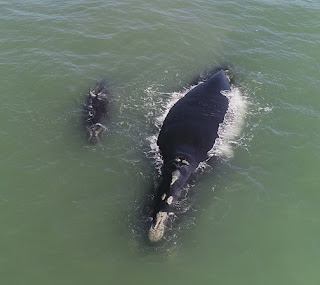The 20th season of the Marineland Right Whale Project began on an upnote. On New Year’s Day, Jim Hain, heading south on Route 95, was at a lunch stop at an IHOP in Virginia when the phone rang. Whales! Julie Albert with the Marine Resources Council relayed a call from a beachwalker in Ormond-by-the-Sea. Dave and Maryann Gustafson, Terry Clark, and Ralph Bundy responded. A drone was launched. It was female Catalog #3560 with her first calf. This mother-calf pair was first reported on 16 December off Georgia. In the following two-week period, they went unsighted. The whales appear. The whales disappear. The New Year’s sighting was the first since the 12/16 date and the first in the state of Florida for this season! It was a holiday with good weather. Lots of people were out and stopped to watch. The Sheriff’s Department helped direct traffic. The Florida Fish & Wildlife survey plane also responded. It was an auspicious start to the 2020 New Year!
During the course of the season, Catalog #3560 and her calf were sighted eight more times by our program―our most-sighted whales for the season. The pair meandered south and north several times. The last sighting by our group was on 12 February at the Gamble Rogers State Park, through a gap in the fog. Then, they swam south of Cape Canaveral and were sighted off Sebastian Inlet, off Miami, and off Key Largo. Then, all was quiet. Next―surprise―they were photographed in the Gulf of Mexico off the Florida panhandle on 11 March. As of 24 March, they are swimming south along the west coast of Florida. Will they pass through the Keys and once again pass through our area? Time will tell. We will keep you posted.
This rare event has occurred before. On 4 December 2005, we sighted female #2503, Boomerang, and calf heading south past Marineland. By January 2006, they had made it around to the Gulf of Mexico and were off Texas. In August and September of that year, the pair was reported in the Bay of Fundy, Nova Scotia, Canada. There is another record of this type. In 2018, a juvenile went into the Gulf of Mexico and was sighted several times off the panhandle and the west coast of Florida.
The other frequently sighted mother-calf pair this season was #3546, Halo, with her second calf. We sighted the pair five times. She is also a traveler. The pair meandered between Crescent Beach and Daytona Beach. On 31 January, photos on social media showed her off Cocoa Beach and Jetty Park (Port Canaveral). They next reappeared moving north on 5 February off Flagler Beach. On 12 March they were reported off Myrtle Beach, SC. We can guess that their northward migration was underway.
The Marineland Right Whale Project had 15 sightings this season. It was our best season in the last four years. We flew our drones on nine occasions, and found that they greatly enhanced/synergized the results from our shore-based network. Using big cameras with long lenses, we obtained shore-based photos on six occasions. We worked with the Florida Fish and Wildlife Team on several occasions to help obtain biopsy samples of two calves (1), and aerial photos of several individuals. We also collaborated with the Marine Resources Council in providing and receiving calls to/from their sighting hotline. Many of our volunteers had right whale sightings, including several dozen who saw their first-ever right whale this season.
Stay tuned to this blog and join us in 2021!
(1) Genetic data provide another valuable information source and a parallel research approach. The DNA in the skin sample provides a genetic identity, and can be used to determine sex, establish paternity and relatedness to other individuals, and help identify whales not photographically identified. There is a genetic database for this information.







